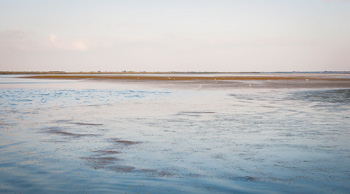Divining the signs of fish

rusty chinnis | sun
Exploring a grass flat at low tide can provide clues to good areas to fish
Catching fish isn’t about being in any particular honey hole. Anglers who know how to look for the signs of the presence of fish are more adept at catching fish no matter what the time, tide or weather. While there’s no secret formula to fishing that assures even the most astute angler success on the water, being aware of the signs that point to action can make the difference between a successful or fishless day.
Most anglers know to look for the obvious signs of action such as a feeding frenzy on the water’s surface or feeding birds hovering over a school of baitfish, prey that’s being driven to the surface by feeding fish. Fewer know that lots of birds feeding on a dry flat at low tide is a good sign of finding fish on the next high tide.
There are many subtle signs that might be missed if you’re not aware when you’re out looking for fish. Savvy anglers know that schools of mullet are a good indication that redfish may be present. Reds often travel with mullet, using their distraction and the fact that they disturb the bottom to point the way to prey such as minnows and shrimp. Many guides will avoid a flat if there are no mullet present.
Another sign of a productive place to fish is the presence of other sea life such as rays, dolphin or even schools of catfish. While this is not a sure sign that your particular prey species might be present, time can be saved if a particular flat or area is barren of any life.
Working the water with an eye to structures that attract fish is a good way to find action when there are no outward signs of activity. Grass flats are known to be productive places to fish because they provide the cover, food and ambush spots for species such as redfish, snook and trout. How to fish a flat and where to concentrate your efforts can be the difference in finding and catching fish. The flats are contoured, and have features such as potholes of bare sand and slues that funnel water on and off the flat. Fish travel these areas as the water rises and falls with the tide. Learning the features of an area before you fish it can pay dividends. This might mean paying attention to the elevations of a particular area during a low tide when the flat is exposed.
Fish often use the exposed sand areas of a flat as an ambush spot. Fishing the potholes on a flat effectively means approaching them quietly from a distance and making casts that cover the area starting on the edges and working across the hole. Often there will be an area of grass at one end of a flat or another. These areas can be particularly productive and should be prospected carefully.
Structure is always worth checking out, whether it’s a jetty in a pass, a rock pile in the bay or a piece of debris that has blown up on a flat. Structure can also include limestone bottom on the Gulf bottom or in the bay, crab traps or even a floating piece of discarded timber or a coconut. Since there isn’t much structure in the open Gulf, small minnows and crustaceans often use what they can find for protection. Predators know this and check out these structures.
Wherever you are keep a sharp eye out for signs of fish that might not be so apparent. Divining the signs, apparent or subtle, can make a big difference in your success on the water.

